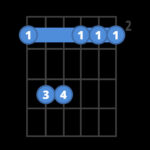Many guitarists who transition to digital amp modelers like the Kemper Profiler often find themselves pondering the nuances of tone, especially concerning frequency response. A common question arises: given that Guitar Speakers are known to operate within a limited frequency range, how do digital profiles capture the full spectrum of guitar tones, including high frequencies? This article delves into the fascinating world of guitar speaker frequencies and their role in digital profiling, aiming to clarify these misunderstandings and optimize your tone, whether you’re playing live or recording in the studio.
Guitar speakers are specifically designed for the frequencies produced by electric guitars. Typically, their frequency response ranges from around 80Hz at the low end to about 5kHz – 6kHz at the high end. This range is perfectly suited for the fundamental frequencies and harmonics that shape the core sound of a guitar. However, when using a Kemper or similar profiling technology, you might notice frequencies extending far beyond this range in your profiles. This is where the magic of microphones and the profiling process comes into play.
The extended frequency range captured in digital profiles originates primarily from the microphones used to capture the sound of the amplifier and cabinet during the profiling process. Studio-quality microphones are designed to be far more sensitive and have a much wider frequency response than guitar speakers. They can easily capture frequencies well beyond 20kHz, encompassing the full spectrum of audio frequencies that contribute to the overall character and detail of a guitar tone.
When a microphone is placed in front of a guitar cabinet for profiling, it doesn’t just capture the sound directly from the speaker cone. It also captures:
- High-frequency harmonics and overtones: These extend beyond the speaker’s fundamental frequency range and add brightness, air, and detail to the tone.
- Cabinet resonance and reflections: The cabinet itself vibrates and resonates, adding complex frequencies that microphones pick up.
- Room ambience (to a degree): Depending on mic placement and room acoustics, some higher frequencies from the room are also captured.
Therefore, the profile created by the Kemper isn’t solely limited to the frequency response of the guitar speaker itself. It’s a holistic capture of the entire sound emanating from the amp and cabinet as perceived by the microphone, which includes frequencies far beyond the speaker’s limitations.
When using your Kemper live through a PA system, it’s common practice to apply a Low-Pass Filter (LPF) to your guitar tone to prevent harsh high frequencies, especially through full-range PA speakers that can reproduce frequencies guitar speakers cannot. Setting an LPF around 6kHz – 7kHz for live use is a good starting point, mirroring the natural roll-off of a guitar speaker cabinet. This helps to create a tone that sits well in a mix and avoids unwanted harshness.
For studio recording, you might consider extending the LPF slightly higher, perhaps around 10kHz – 10.5kHz. In a studio environment, you often have more control over the overall mix, and retaining some of the higher frequencies captured in the profile can add clarity and detail. However, it’s crucial to listen critically in the context of the mix and adjust the LPF accordingly.
Regarding High-Pass Filters (HPF), these are also important for sculpting your tone. While guitar speakers inherently roll off low frequencies below 80Hz, using an HPF around this range can help to tighten up your low end, remove unwanted rumble, and create clarity, particularly in high-gain scenarios.
Ultimately, while understanding the frequency range of guitar speakers is informative, remember that digital profiling captures a much wider sonic picture thanks to microphones. Experiment with LPF and HPF settings in your Kemper to shape your tone for both live and studio applications. Trust your ears and adjust according to the specific context and desired sound. The goal is to achieve a balanced and pleasing tone that works effectively in your mix, whether you are aiming for a realistic amp-in-the-room sound or exploring new sonic territories.

